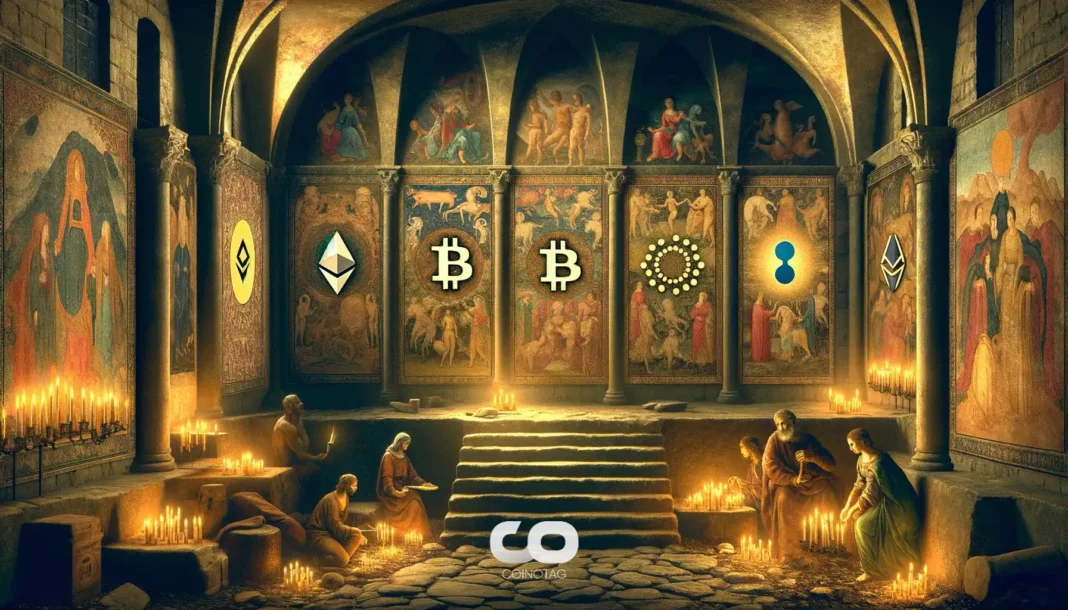| COINOTAG recommends • Exchange signup |
| 💹 Trade with pro tools |
| Fast execution, robust charts, clean risk controls. |
| 👉 Open account → |
| COINOTAG recommends • Exchange signup |
| 🚀 Smooth orders, clear control |
| Advanced order types and market depth in one view. |
| 👉 Create account → |
| COINOTAG recommends • Exchange signup |
| 📈 Clarity in volatile markets |
| Plan entries & exits, manage positions with discipline. |
| 👉 Sign up → |
| COINOTAG recommends • Exchange signup |
| ⚡ Speed, depth, reliability |
| Execute confidently when timing matters. |
| 👉 Open account → |
| COINOTAG recommends • Exchange signup |
| 🧭 A focused workflow for traders |
| Alerts, watchlists, and a repeatable process. |
| 👉 Get started → |
| COINOTAG recommends • Exchange signup |
| ✅ Data‑driven decisions |
| Focus on process—not noise. |
| 👉 Sign up → |
-
Ethereum developers are making strides to unify cross-chain address formats with new standards ERC-7930 and ERC-7828, aimed at enhancing multichain user experience.
-
These innovations aim to tackle the confusion surrounding asset transfers across various blockchains, establishing a more cohesive framework for decentralized applications.
-
“The current solution offers a patchwork of different rules, making cross-chain transactions problematic,” emphasized Wonderland, the organization behind the initiative.
Discover how Ethereum’s ERC-7930 and ERC-7828 standards aim to simplify cross-chain transactions and enhance the multichain experience for users.
New Standards for Streamlining Blockchain Interactions
Ethereum is taking a significant step forward with the proposal of ERC-7930, which introduces a compact binary format tailored for interoperable addresses. This new structure is designed to be machine-friendly, optimizing the interactions required for protocols across different blockchains.
ERC-7828 complements this by adding a human-readable layer, utilizing formats akin to address@chain, which enhances clarity for everyday users. Together, these standards provide a comprehensive solution intended to elevate Ethereum’s inter-blockchain usability, bridging the gap between machine requirements and user experience.
The Benefits of an Integrated Approach
The ERC-7828 is particularly critical as it targets the protocol’s interaction with human users, establishing a straightforward textual layer that simplifies communication. Teddy from Wonderland underscored its necessity, stating, “The target audience for ERC-7828 is anything that interacts with humans… It’s the text layer.”
| COINOTAG recommends • Professional traders group |
| 💎 Join a professional trading community |
| Work with senior traders, research‑backed setups, and risk‑first frameworks. |
| 👉 Join the group → |
| COINOTAG recommends • Professional traders group |
| 📊 Transparent performance, real process |
| Spot strategies with documented months of triple‑digit runs during strong trends; futures plans use defined R:R and sizing. |
| 👉 Get access → |
| COINOTAG recommends • Professional traders group |
| 🧭 Research → Plan → Execute |
| Daily levels, watchlists, and post‑trade reviews to build consistency. |
| 👉 Join now → |
| COINOTAG recommends • Professional traders group |
| 🛡️ Risk comes first |
| Sizing methods, invalidation rules, and R‑multiples baked into every plan. |
| 👉 Start today → |
| COINOTAG recommends • Professional traders group |
| 🧠 Learn the “why” behind each trade |
| Live breakdowns, playbooks, and framework‑first education. |
| 👉 Join the group → |
| COINOTAG recommends • Professional traders group |
| 🚀 Insider • APEX • INNER CIRCLE |
| Choose the depth you need—tools, coaching, and member rooms. |
| 👉 Explore tiers → |
By bridging the gap between machine processes and user navigation, Ethereum aims to bolster participation in its decentralized finance (DeFi) ecosystem by making transactions simpler and less error-prone. These enhancements are crucial as the blockchain sphere continues to expand and complexity increases.
A Unified Address for Multiple Blockchains
One of the standout features of these proposed standards is the ability to specify the target blockchain when sending a payment address. This feature effectively combines a human-readable format with a machine-readable format intended for application programming interfaces (APIs).
| COINOTAG recommends • Exchange signup |
| 📈 Clear interface, precise orders |
| Sharp entries & exits with actionable alerts. |
| 👉 Create free account → |
| COINOTAG recommends • Exchange signup |
| 🧠 Smarter tools. Better decisions. |
| Depth analytics and risk features in one view. |
| 👉 Sign up → |
| COINOTAG recommends • Exchange signup |
| 🎯 Take control of entries & exits |
| Set alerts, define stops, execute consistently. |
| 👉 Open account → |
| COINOTAG recommends • Exchange signup |
| 🛠️ From idea to execution |
| Turn setups into plans with practical order types. |
| 👉 Join now → |
| COINOTAG recommends • Exchange signup |
| 📋 Trade your plan |
| Watchlists and routing that support focus. |
| 👉 Get started → |
| COINOTAG recommends • Exchange signup |
| 📊 Precision without the noise |
| Data‑first workflows for active traders. |
| 👉 Sign up → |
This dual-layer approach will mitigate the risk of crypto losses due to sending or receiving assets on the incorrect blockchain—an issue prevalent in the current landscape where identical addresses may exist across various blockchains. By allowing for a blockchain-agnostic wallet operation, users will have a streamlined interface that dictates the transaction’s direction based on the input address.
Consequently, this will alleviate friction experienced in managing multiple networks, allowing users to focus on their transactions rather than the technicalities of network settings.
| COINOTAG recommends • Traders club |
| ⚡ Futures with discipline |
| Defined R:R, pre‑set invalidation, execution checklists. |
| 👉 Join the club → |
| COINOTAG recommends • Traders club |
| 🎯 Spot strategies that compound |
| Momentum & accumulation frameworks managed with clear risk. |
| 👉 Get access → |
| COINOTAG recommends • Traders club |
| 🏛️ APEX tier for serious traders |
| Deep dives, analyst Q&A, and accountability sprints. |
| 👉 Explore APEX → |
| COINOTAG recommends • Traders club |
| 📈 Real‑time market structure |
| Key levels, liquidity zones, and actionable context. |
| 👉 Join now → |
| COINOTAG recommends • Traders club |
| 🔔 Smart alerts, not noise |
| Context‑rich notifications tied to plans and risk—never hype. |
| 👉 Get access → |
| COINOTAG recommends • Traders club |
| 🤝 Peer review & coaching |
| Hands‑on feedback that sharpens execution and risk control. |
| 👉 Join the club → |
Collaborative Development for Enhanced Feedback
The involvement of multiple DeFi protocols, such as Optimism, Aztec, Connext, and Yearn, signifies a collaborative commitment to enhancing Ethereum’s ecosystem. The development group, Wonderland, has made an explicit call for community feedback on the ETH-Magicians forum, stressing the importance of collective insight in refining these standards before their finalization.
Decentralization thrives on collaboration, and the input from diverse stakeholders will be pivotal in ensuring that these new standards align with the needs and expectations of users across the Ethereum landscape.
Looking Ahead: A Simplified Multichain Future
With the impending completion of ERC-7930 and ERC-7828, Ethereum sets its sights on fostering a more integrated and user-friendly environment. This initiative aims to lower barriers for users and developers alike, potentially ushering in a new era of usability in multi-chain transactions.
As developers finalize the details, the anticipation surrounding these token standards indicates a broader trend towards simplifying blockchain interactions across the decentralized finance sphere.
| COINOTAG recommends • Exchange signup |
| 📈 Clear control for futures |
| Sizing, stops, and scenario planning tools. |
| 👉 Open futures account → |
| COINOTAG recommends • Exchange signup |
| 🧩 Structure your futures trades |
| Define entries & exits with advanced orders. |
| 👉 Sign up → |
| COINOTAG recommends • Exchange signup |
| 🛡️ Control volatility |
| Automate alerts and manage positions with discipline. |
| 👉 Get started → |
| COINOTAG recommends • Exchange signup |
| ⚙️ Execution you can rely on |
| Fast routing and meaningful depth insights. |
| 👉 Create account → |
| COINOTAG recommends • Exchange signup |
| 📒 Plan. Execute. Review. |
| Frameworks for consistent decision‑making. |
| 👉 Join now → |
| COINOTAG recommends • Exchange signup |
| 🧩 Choose clarity over complexity |
| Actionable, pro‑grade tools—no fluff. |
| 👉 Open account → |
Conclusion
In summary, the proposed ERC-7930 and ERC-7828 standards represent a significant leap towards unifying Ethereum’s cross-chain address formats. By prioritizing a machine-friendly approach alongside a human-readable layer, Ethereum aims to enhance user experience while facilitating smoother interactions across blockchains. As the Ethereum community rallies for feedback, the future looks promising for a streamlined and efficient multichain ecosystem.
| COINOTAG recommends • Members‑only research |
| 📌 Curated setups, clearly explained |
| Entry, invalidation, targets, and R:R defined before execution. |
| 👉 Get access → |
| COINOTAG recommends • Members‑only research |
| 🧠 Data‑led decision making |
| Technical + flow + context synthesized into actionable plans. |
| 👉 Join now → |
| COINOTAG recommends • Members‑only research |
| 🧱 Consistency over hype |
| Repeatable rules, realistic expectations, and a calmer mindset. |
| 👉 Get access → |
| COINOTAG recommends • Members‑only research |
| 🕒 Patience is an edge |
| Wait for confirmation and manage risk with checklists. |
| 👉 Join now → |
| COINOTAG recommends • Members‑only research |
| 💼 Professional mentorship |
| Guidance from seasoned traders and structured feedback loops. |
| 👉 Get access → |
| COINOTAG recommends • Members‑only research |
| 🧮 Track • Review • Improve |
| Documented PnL tracking and post‑mortems to accelerate learning. |
| 👉 Join now → |







